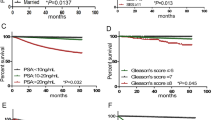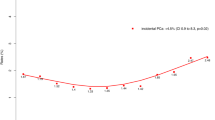Abstract
Background
To examine clinical characteristics, treatment modalities and oncological outcomes of prostate cancer (PCa) according to young (≤50) vs. old age.
Methods
Of 407,599 men with primary adenocarcinoma of the prostate within the Surveillance, Epidemiology and End Results (SEER)-database (2004 to 2013), 18,387 were aged ≤50 years (4.5%). Time trends, cumulative incidence, and competing risks regression (CRR) analyses tested for differences between young and old patients. Multi-variable analyses were adjusted for year of diagnosis, race, marital status, Gleason Score, clinical tumor stage, and lymph node status.
Results
Younger men had more favorable tumor characteristics: lower Gleason Score, lower median PSA, and lower rates of metastases at diagnosis compared to their older counterparts. Over time, no local treatment (NLT) rates increased, radical prostatectomy (RP), and brachytherapy (BT) rates decreased and external beam radiation (EBRT) rates remained unchanged. Moreover, the rate of de novo metastatic prostate cancer increased in young patients from 2% (2004) to 3.2% (2013) (p = 0.004). CRR models showed no difference in prostate cancer-specific mortality (PCSM) between young and old, across all local treatment types.
Conclusions
Young PCa patients have more favorable disease characteristics at presentation, are less frequently treated with RP or BT and more frequently benefit of NLT. PCSM did not differ between young and old patients. However, it is worrisome that recently more young PCa patients are diagnosed at a metastatic stage.
This is a preview of subscription content, access via your institution
Access options
Subscribe to this journal
Receive 4 print issues and online access
$259.00 per year
only $64.75 per issue
Buy this article
- Purchase on Springer Link
- Instant access to full article PDF
Prices may be subject to local taxes which are calculated during checkout



Similar content being viewed by others
References
Siegel RL, Miller KD, Jemal A. Cancer statistics, 2016. CA Cancer J Clin. 2016;66:7–30.
Huben R, Natarajan N, Pontes E, Mettlin C, Smart CR, Murphy GP. Carcinoma of prostate in men less than fifty years old. Data from American college of surgeons’ national survey. Urology. 1982;20:585–8.
Johnson DE, Lanieri JP Jr, Ayala AG. Prostatic adenocarcinoma occurring in men under 50 years of age. J Surg Oncol. 1972;4:207–16.
Sandhu DP, Munson KW, Benghiat A, Hopper IP. Natural history and prognosis of prostate carcinoma in adolescents and men under 35 years of age. Br J Urol. 1992;69:525–9.
Parker PM, Rice KR, Sterbis JR, Chen Y, Cullen J, McLeod DG, et al. Prostate cancer in men less than the age of 50: a comparison of race and outcomes. Urology. 2011;78:110–5.
Lin DW, Porter M, Montgomery B. Treatment and survival outcomes in young men diagnosed with prostate cancer: a population-based cohort study. Cancer. 2009;115:2863–71.
Smith CV, Bauer JJ, Connelly RR, Seay T, Kane C, Foley J, et al. Prostate cancer in men age 50 years or younger: a review of the department of defense center for prostate disease research multicenter prostate cancer database. J Urol. 2000;164:1964–7.
Kinnear NJ, Kichenadasse G, Plagakis S, O’Callaghan ME, Kopsaftis T, Walsh S, et al. Prostate cancer in men aged less than 50 years at diagnosis. World J Urol. 2016;34:1533–9.
Loeb S, Hernandez DJ, Mangold LA, Humphreys EB, Agro M, Walsh PC, et al. Progression after radical prostatectomy for men in their thirties compared to older men. BJU Int. 2008;101:1503–6.
Prendeville S, Nesbitt ME, Evans AJ, Fleshner NE, van der Kwast TH, Variant histology and clinicopathologic features of prostate cancer in men aged <50 years treated with radical prostatectomy. J Urol. 2017;98:79–8
Wright JL, Lin DW, Cowan JE, Carroll PR, Litwin MS, Ca PI. Quality of life in young men after radical prostatectomy. Prostate Cancer Prostatic Dis. 2008;11:67–73.
Freedland SJ, Presti JC Jr., Kane CJ, Aronson WJ, Terris MK, Dorey F, et al. Do younger men have better biochemical outcomes after radical prostatectomy? Urology. 2004;63:518–22.
Samadi DB, Sebrow D, Hobbs AR, Bernstein AN, Brajtbord J, Lavery HJ, et al. Clinicopathological, functional, and immediate oncologic outcome assessment in men aged </=50 years with prostate cancer after robotic prostatectomy. Urol Oncol. 2017;35:30 e17–30 e24.
Esteve J, Benhamou E, Raymond L. Statistical methods in cancer research. Volume IV. Descriptive epidemiology. London: IARC Scientific Publications; 1994. p. 1–302.
Gray RJ. A class of K-sample tests for comparing the cumulative incidence of a competing risk. Ann Stat. 1988;16:1141–54.
Scrucca L, Santucci A, Aversa F. Regression modeling of competing risk using R: an in depth guide for clinicians. Bone Marrow Transplant. 2010;45:1388–95.
Becker A, Tennstedt P, Hansen J, Trinh QD, Kluth L, Atassi N, et al. Functional and oncological outcomes of patients aged <50 years treated with radical prostatectomy for localised prostate cancer in a European population. BJU Int. 2014;114:38–45.
SEER cancer stat facts: prostate cancer. National Cancer Institute website. https://seer.cancer.gov/statfacts/html/prost.html (2017). Accessed 8 Aug 2017.
Moyer VA, Force USPST. Screening for prostate cancer: U.S. Preventive Services Task Force recommendation statement. Ann Intern Med. 2012;157:120–34.
Bhindi B, Mamdani M, Kulkarni GS, Finelli A, Hamilton RJ, Trachtenberg J, et al. Impact of the U.S. preventive services task force recommendations against prostate specific antigen screening on prostate biopsy and cancer detection rates. J Urol. 2015;193:1519–24.
Barocas DA, Mallin K, Graves AJ, Penson DF, Palis B, Winchester DP, et al. Effect of the USPSTF grade D recommendation against screening for prostate cancer on incident prostate cancer diagnoses in the United States. J Urol. 2015;194:1587–93.
Weiner AB, Matulewicz RS, Eggener SE, Schaeffer EM. Increasing incidence of metastatic prostate cancer in the United States (2004-2013). Prostate Cancer Prostatic Dis. 2016;19:395–7.
Burri RJ, Ho AY, Forsythe K, Cesaretti JA, Stone NN, Stock RG. Young men have equivalent biochemical outcomes compared with older men after treatment with brachytherapy for prostate cancer. Int J Radiat Oncol Biol Phys. 2010;77:1315–21.
Author information
Authors and Affiliations
Corresponding author
Ethics declarations
Conflict of interests
The authors declare that they have no competing interests.
Additional information
Raisa S. Pompe and Ariane Smith contributed equally to this work
Rights and permissions
About this article
Cite this article
Pompe, R.S., Smith, A., Bandini, M. et al. Tumor characteristics, treatments, and oncological outcomes of prostate cancer in men aged ≤50 years: a population-based study. Prostate Cancer Prostatic Dis 21, 71–77 (2018). https://doi.org/10.1038/s41391-017-0006-9
Received:
Accepted:
Published:
Issue Date:
DOI: https://doi.org/10.1038/s41391-017-0006-9
This article is cited by
-
Long-term outcomes of penile squamous cell carcinoma in men age ≤50 years old compared with men >50 years old from a single tertiary referral centre: a propensity score matched analysis
International Journal of Impotence Research (2024)
-
Robotic-assisted radical prostatectomy in young adults: age-stratified oncological and functional outcomes
Journal of Robotic Surgery (2021)
-
Tumor characteristics, oncological and functional outcomes after radical prostatectomy in very young men ≤ 45 years of age
World Journal of Urology (2020)
-
An ecological momentary assessment of self-management in prostate cancer survivors
Journal of Cancer Survivorship (2019)
-
Survival outcomes of locally advanced prostate cancer in patients aged < 50 years after local therapy in the contemporary US population
International Urology and Nephrology (2018)



